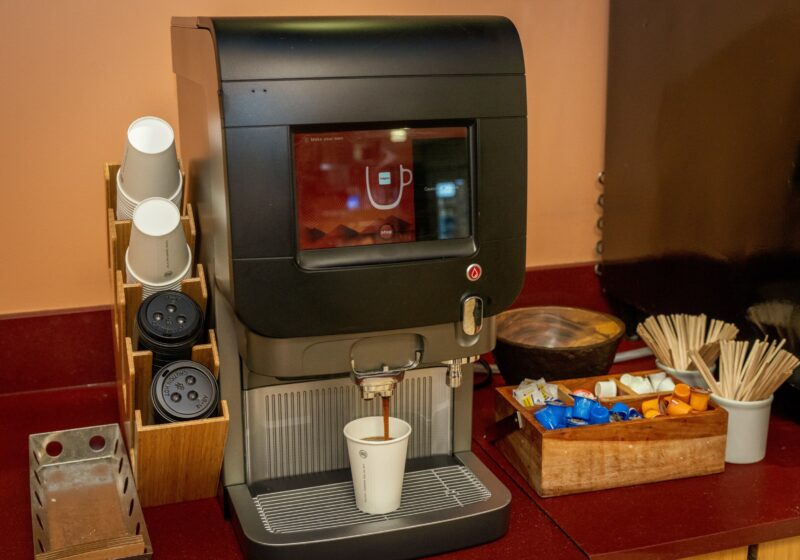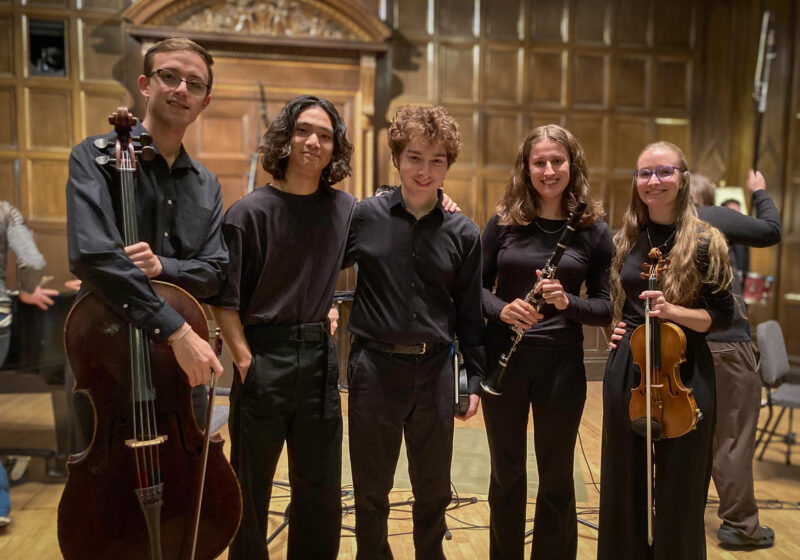To the highest reaches of the Rush Rhees bell tower our jangly elevator rises. It opens to a landing and a flight of stairs that affords glimpses of the River Campus through the tower windows. Our destination is the University’s famed Hopeman Memorial Carillon — the source of the mesmeric music that can be heard evenings on the campus. My romantic preconception is a spectacular view of the moonlit campus beyond large bronze bells that sway at the top of the library’s tower. Maybe even home to a hunchback or two.
Arrival at the carillon’s home, however, disproves my majestic notions, as we enter a platform encased with wire fence and lacking a panorama. This is where the instrument’s console, or keyboard, is located. The structure of the carillon is similar to that of a piano, with large jutting wooden knobs in place of the ivory and ebony keys. The knobs, which resemble the handles of broomsticks, are arranged chromatically and are meant to be struck adeptly with a closed fist.
Each knob is attached to a steel wire, which, when pulled, causes a hammer to strike a bell, representing a unique tone. A row of foot pedals at the base of the console duplicates some of the lower notes of the bass clef. This allows for greater versatility as one can play a melody on the higher tones with the knobs while accompanying harmonically with the foot pedals. “It’s a full body workout,” junior Dong Han said as he took a seat at the console’s raised bench and began to hammer away. His awkward, sporadically ham-handed maneuvers, however, gave way to the beautiful sonority of the bells.
Doris Aman sees herself more as a facilitator than a director for the carillon program. She came to the University three years ago at the request of alumnus Jeff Le. During his time as a KEY Scholar, Le developed a plan to repair the console’s landing and offer students the opportunity to learn the carillon. Aman now provides lessons on a weekly basis and is a caring and attentive instructor. Her goal is to introduce the students to the carillon and help them attain the musical and leadership capabilities that will enable them to be future mentors. “The idea is for them to use this as an opportunity to apply their musical skills,” Ms. Aman said. “It is a time to exercise leadership, to learn how to do publicity, to compose, to arrange, anything that they want to do –– they can use this instrument as a springboard to do that.”
The Carillon can be heard on Wednesday, Thursday and Friday evenings, during Aman’s lesson times. Three or more carillonneurs take the trek up to the console’s platform, helping each other out on difficult pieces. They choose from the University’s library of music composed for the carillon and also practice with traditional scales, exercises and “drills.”
“It is meant to be enjoyed by the rest of campus,” Han said. “So something a little more contemporary might be more suitable.” Hence, Harry Potter tunes and a rendition of Lady Gaga’s “Bad Romance.” More complicated tunes are team efforts, the former requiring three players and the latter two.
“I’m learning a lot from it,” freshman Andrew Hevey, a trumpet player foreign to the world of keyboard instruments, said. He was attracted to the program through an on-campus advertisement and was quickly taken in by Aman and the “veteran” carillonneurs.
Freshman Xin Xu, a Chinese bamboo flautist, had no knowledge of traditional sheet music and music theory when coming into the program. “Aman and Dong, my mentors, are very, very helpful,” Xu said. “They will teach you no matter whether you know how to play or not. The more experienced players help the novices, or ‘Paduans’ as Han puts it, get ‘up and running.’”
He too teaches Xu to read sheet music and guides him in one-on-one practice sessions on the mock carillon located in Spurrier Hall.
The diverse musical and educational backgrounds of the novice carillonneurs testify to the openness of the program. With no prior knowledge of the carillon, or even music, required, many biology and engineering majors are taking up this enticing, one-of-a-kind offer.
“It’s the rare opportunity, or the only opportunity, for me to touch professional music in my life,” Xu said. “If I go to graduate school or follow a business career, I cannot play this instrument anymore.”
The enthusiasm and dedication of the students and their teacher are unique to the environment of the carillon program. Aman, the novice carillonneurs, and their mentors have formed a close-knit community of musicians intrigued by this rare device.
Emphasis is placed on patience. The carillon, being new to most, requires the same amount of time, practice and mistakes as any other musical instrument. So if you hear an off note or some less than interesting scales, take the time to realize that someone is learning to play an instrument you probably never heard of until you read this article.
And just in case you’re wondering, the chimes you hear on the quarter are automated and use a separate set of bells. To be manual would require a full time hunchback and the subsequent costs of health care coverage, salary, benefits, etc.
The carillonneurs will be providing a free concert on Meliora Weekend as part of the “Brass Choir Fanfares and Ringing of the Carillon” event Saturday Oct. 16 at noon. You can also look forward to something a little more danse macabre during this year’s Scare Fair at Rush Rhees.
Colaruotolo is a member of the class of 2012.




